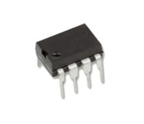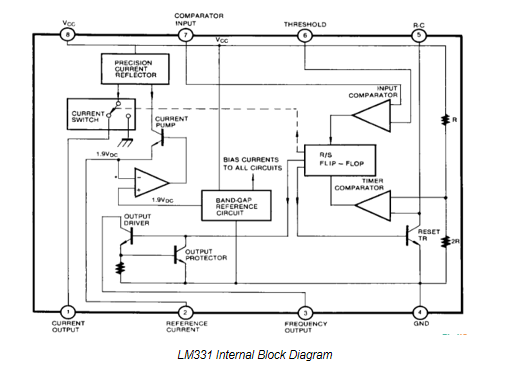LM331 Comprehensive Guide: Precision Voltage to Frequency Converters
Catalog
LM331 Description

The LM331 is a high-performance and relatively low-cost integrated chip produced by NS Company in the United States. It can be used as a precision frequency-to-voltage converter, A/D converter, linear frequency modulation and demodulation, long-time integrator, and other related devices. The LM331 utilizes a new temperature-compensated energy-gap reference circuit, which provides extremely high accuracy over the entire operating temperature range and down to a supply voltage of 4.0 V. The LM331 has a wide dynamic range of 100 dB; its linearity is also excellent, with a maximum nonlinear distortion of less than 0.01 percent, and it maintains good linearity performance even at operating frequencies as low as 0.1 Hz. In addition, its conversion accuracy is also quite high, the digital resolution can reach 12 bits. In terms of application, the external circuit design of LM331 is relatively simple, and it is easy to form conversion circuits such as V/F or F/V by accessing only a few external components. At the same time, due to the optimized design of its internal circuits, the conversion accuracy can also be well guaranteed.
Alternatives and equivalents:
• AS331
• LM3310SQ
Functions and Roles of LM331
The main function of LM331 is to convert the input analog signal into frequency output. It uses an internal comparator and voltage-controlled oscillator (VCO) to achieve this function. When the input signal exceeds the set threshold, the comparator will output a high-level signal, causing the VCO's output frequency to increase. On the contrary, when the input signal is lower than the threshold, the comparator will output a low-level signal, causing the VCO's output frequency to decrease. Therefore, the LM331 chip can convert the size of the input signal into a change in the output frequency.
LM331 has a wide range of applications in measurement, control, and communication equipment. For example, when measuring physical quantities such as temperature and humidity, the LM331 chip can be used to convert the sensor's output signal into a frequency signal for convenient digital processing. In addition, it can also be used in digital communication systems to convert analog signals into digital signals, thereby improving the anti-interference performance and reliability of the system.
LM331 Internal Block Diagram

The internal circuit of LM331 is mainly composed of an input comparator, output driver tube, RS flip-flop, current switch, timing comparator, reset transistor, output protection tube, bandgap reference circuit, and precision current source circuit. The output driver tube adopts an open-collector form. Therefore, by selecting appropriate logic current and external resistor, the user can flexibly change the logic level of the output pulse to adapt to the needs of different logic circuits such as TTL, DTL, CMOS, etc. In addition, LM331 can be powered by either dual power supply or single power supply. It has a wide operating voltage range and can operate between 4V to 40V, and the output voltage can be as high as 40V. At the same time, LM331 also has the function of preventing Vcc short circuit to ensure the safe operation of the circuit.
Working Principle of LM331
The core of the LM331 is a voltage comparator based on CMOS technology, the output of which is fed into an external correction capacitor and built-in current source. When the input voltage is equal to the internal reference voltage, the output level of the voltage comparator is inverted. This process controls the gain of the input signal through a negative feedback loop, thereby generating a rectangular wave with a fixed amplitude and changing period at the output end. In addition, the LM331 is equipped with a special logarithmic slope generator circuit. This circuit converts the difference between the input voltage and the reference voltage into a frequency delta, enabling precise voltage-to-frequency conversion. At the same time, LM331 provides 4 programmable measurement ranges to meet the needs of different application scenarios. What's more worth mentioning is that LM331 also allows users to adjust the rise and fall times of the output waveform through external resistors. This feature not only enhances its flexibility but also helps achieve greater accuracy and stability.
Application Circuit of LM331

The picture above is a voltage/frequency conversion circuit composed of LM331 and other components. LM331 is a monolithic voltage/frequency conversion integrated circuit that integrates on-chip 1.9V reference voltage, current switch, comparator, and flip-flop functions. In order to expand the measurement range, an A1 operational amplifier is added to the circuit. The reference current IR is set by (Rl+R(RPl)). Since the internal reference voltage is 1.9V, IR=1.9V/(Rl+R(RPl)). The usual setting range is between 100μA and 500μA.
In addition, the average current I at the output (pin 1) of the current switch is equal to the input current Ii. For the on-chip charge and discharge circuit, when the charging voltage reaches a certain threshold of the power supply voltage (such as 2/3 of the power supply voltage), the circuit is reset, so the pulse width is equal to 1.1/R4C3. Since the input current Ii is equal to 1.1/R4 x C3 x f0 x IR, the input current Ii is proportional to the oscillation frequency f0, that is, the output frequency f0 is proportional to the input voltage Ui.
Specific Applications of LM331
The LM331 is widely used in a variety of applications that require converting input voltage into frequency signals. The following are several common application areas of LM331:
Frequency Synthesis
LM331 can be used in frequency synthesis applications. By connecting multiple LM331s in series or parallel, the synthesized output of multiple frequencies can be achieved. This is of great significance in some applications that require multi-frequency signals, such as communication systems, signal generators, etc.
Frequency Measurement
LM331 can convert the input voltage into a frequency output proportional to the input voltage, so it has a wide range of applications in the field of frequency measurement. For example, in instrumentation, LM331 can be used to measure the frequency of voltage, current, temperature, and other parameters, and provide the frequency signal to a display or other processing circuit for processing and display.
Digitization of Analog Signals
In the process of digitizing analog signals, LM331 can convert the analog signal into a frequency representation of a digital signal. This is very useful in applications that require digital processing of analog signals, such as data acquisition, sound processing, and other fields.
Waveform Generator
Since LM331 can convert the input voltage into a frequency signal, it can be used as the core component of the waveform generator. By adjusting the input voltage, LM331 can output signals of different frequencies, thereby generating various waveforms, such as sine waves, square waves, triangle waves, etc.
Precautions for Using LM331
When using LM331, there are several important considerations to consider:
Circuit Protection: We can add the necessary protection circuits, such as voltage regulators, power supply filter capacitors, and over-voltage protection diodes, etc., to protect the LM331 from external environmental interference and damage.
Input Impedance: LM331 has a high input impedance, usually between 10kΩ and 100kΩ. When designing the circuit, we should choose the appropriate input impedance to ensure the stability and accuracy of the input signal.
Input Voltage: When using the LM331, we should ensure that the input voltage is within the specified operating range and maintain its stability. Be sure to avoid the input voltage out of the specified range to prevent damage to the LM331.
Electrostatic Discharge Protection: The LM331 contains electrostatic sensitive parts. Therefore, during operation, avoid touching the sensitive parts of the chip directly and take appropriate electrostatic protection measures to prevent damage to the chip caused by electrostatic discharge.
Supply Voltage: The LM331 usually requires a single power supply, with a supply voltage ranging from 3V to 30V. We need to ensure that the power supply voltage provided to LM331 is within the specified range and has sufficient stability and reliability.
Temperature Stability: The performance of the LM331 is greatly affected by temperature. Therefore, when used in environments with large temperature variations, we need to pay special attention to the effect of temperature on the LM331 and may need to take temperature compensation measures to improve its stability.
Frequently Asked Questions [FAQ]
1. What is the cost of LM331 in India?
LM331 Voltage Frequency Converter 0-10V to 0-10KHz Conversion Module at Rs 199.00.
2. What is LM331?
The LM231/LM331 family of voltage-to-frequency converters are ideally suited for use in simple low-cost circuits for analog-to-digital conversion, precision frequency-to-voltage conversion, long-term integration, linear frequency modulation or demodulation, and many other functions.
3. How does LM331 work?
The output driver of LM331 adopts the open-collector form, so the logic level of the output pulse can be flexibly changed by selecting the logic current and external resistance to adapt to different logic circuits such as TTL, DTL and CMOS.
4. What is the voltage to frequency converter using LM331?
This voltage to frequency converter provides the output pulse train at a frequency precisely proportional to the applied input voltage. The LM331 can operate at power supplies as low as 4.0V and be changed output frequency from 1Hz to 100KHz.
5. What is the use of LM331 V to F converter?
This voltage to frequency converter provides the output pulse train at a frequency precisely proportional to the applied input voltage. The LM331 can operate at power supplies as low as 4.0V and be changed output frequency from 1Hz to 100KHz.